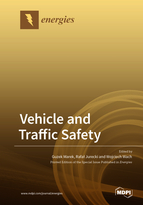Vehicle and Traffic Safety
A special issue of Energies (ISSN 1996-1073). This special issue belongs to the section "E: Electric Vehicles".
Deadline for manuscript submissions: closed (31 January 2022) | Viewed by 77348
Special Issue Editors
Interests: vehicle dynamics; vehicle safety; accident analysis, accident reconstruction
Special Issues, Collections and Topics in MDPI journals
Interests: research and modeling of driver behavior, active and passive safety of vehicles, vehicle testing, analysis of the causes of accidents
Special Issues, Collections and Topics in MDPI journals
Special Issue Information
Dear Colleagues,
The role of the road transport of people and goods is increasing. Despite significant progress in the development of car design and road safety improvement programs, the number of accidents and their casualties, as well as the related economic and social costs, remains unsatisfactory. In this context, it is extremely important to develop and exchange knowledge on contemporary car safety problems, interactions in the vehicle–human–road system, the development of car construction, and methods of analyzing road accidents. We invite researchers, specialists, and industry representatives to publish their achievements on various topics in the areas of ground vehicle transport and automotive engineering: active and passive vehicle safety, vehicle dynamics and stability, accident analysis and reconstruction, vehicle (and its assemblies) testing; safety of alternative vehicle drives, including electric and hybrid; and the impact on road safety of aspects such as traffic control systems, road infrastructure (including street and road lighting), autonomous and connected vehicles, and human factors.
We are convinced that the collection of high-quality articles on the above-mentioned topics in this Special Issue of the journal will bring a great deal of valuable experience to everyone.
Dr. Guzek Marek
Dr. Rafał Jurecki
Dr. Wojciech Wach
Guest Editors
Manuscript Submission Information
Manuscripts should be submitted online at www.mdpi.com by registering and logging in to this website. Once you are registered, click here to go to the submission form. Manuscripts can be submitted until the deadline. All submissions that pass pre-check are peer-reviewed. Accepted papers will be published continuously in the journal (as soon as accepted) and will be listed together on the special issue website. Research articles, review articles as well as short communications are invited. For planned papers, a title and short abstract (about 100 words) can be sent to the Editorial Office for announcement on this website.
Submitted manuscripts should not have been published previously, nor be under consideration for publication elsewhere (except conference proceedings papers). All manuscripts are thoroughly refereed through a single-blind peer-review process. A guide for authors and other relevant information for submission of manuscripts is available on the Instructions for Authors page. Energies is an international peer-reviewed open access semimonthly journal published by MDPI.
Please visit the Instructions for Authors page before submitting a manuscript. The Article Processing Charge (APC) for publication in this open access journal is 2600 CHF (Swiss Francs). Submitted papers should be well formatted and use good English. Authors may use MDPI's English editing service prior to publication or during author revisions.
Keywords
- ground vehicle safety
- vehicle active safety
- vehicle passive safety
- accident analysis
- accident reconstruction
- vehicle dynamics
- vehicle stability and handling
- autonomous vehicles
- autonomous and connected vehicles
- vehicle testing
- safety of electric/hybrid cars
- driving simulators
- visibility (recognizability) of pedestrians and obstacles
- lighting of vehicles and roads
- crashworthiness
- road safety infrastructure
- traffic control systems
- traffic organization








